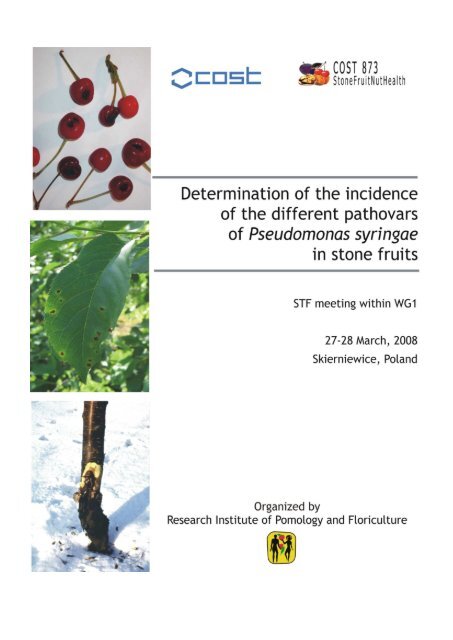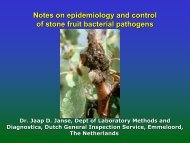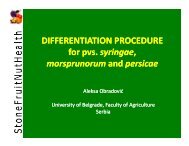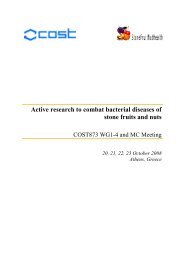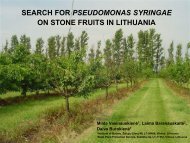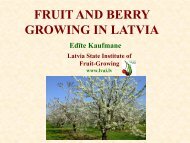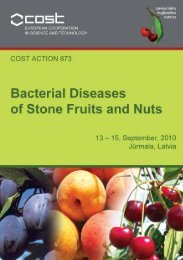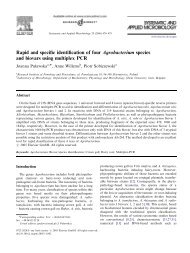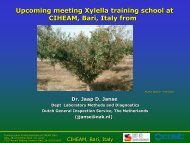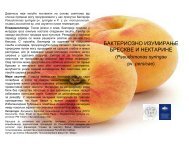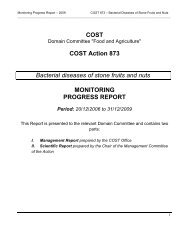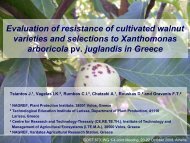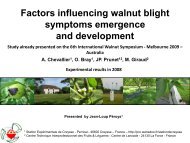Pseudomonas meeting - Cost 873
Pseudomonas meeting - Cost 873
Pseudomonas meeting - Cost 873
- No tags were found...
You also want an ePaper? Increase the reach of your titles
YUMPU automatically turns print PDFs into web optimized ePapers that Google loves.
Organizing CommiteeJoanna PuławskaAlain BultreysPiotr Sobiczewski2
COST <strong>873</strong> StoneFruitNutHealthSTF Meeting on “Determination of the incidence of the different pathovars of<strong>Pseudomonas</strong> syringae in stone fruits”27 th -28 th March 2008, Skierniewice, Poland27th March - Thursday8:30h Registration, handing over documents9:30h Welcome sessionSession 1: Occurrence of <strong>Pseudomonas</strong> syringae on stone fruits in Europe9:45h – 10:10h Research on <strong>Pseudomonas</strong> syringae – pathogen of stone fruit trees inPoland – the past and the future.Joanna Puławska, Piotr Sobiczewski, Monika Sulikowska10:10h – 10:35h Presentation of the <strong>Pseudomonas</strong> syringae pathovars encountered oncherry and plum and their occurrence in BelgiumAlain Bultreys10:35h – 11:00h Occurrence of <strong>Pseudomonas</strong> syringae pathovars in stone fruits in theNetherlands and availability of strains from different hosts of thispathogen.Jaap D. Janse, Alexander van Beuningen, Marcel Wenneker11:00h - 11:30h CoffeeSession 2 (to be continued): Occurrence of <strong>Pseudomonas</strong> syringae on stone fruits in Europe11:30h – 11:50h Information on peach bacterial canker in Aegean Region of TurkeyHatice Ozaktan, Ahmet Akkopru, Adem Bozkurt, Mine Erdal11:50h – 12:10h Search for <strong>Pseudomonas</strong> syringae on stone fruits in LithuaniaMilda Vasinauskienė, Laima Baranauskaitė, Daiva Burokienė12:10h – 12:30h Identification of stone fruits phytopathogenic Pseudomonads in theCzech RepublicJaroslav HORKÝ12:30h – 12:50h Bacterial diseases caused by <strong>Pseudomonas</strong> sp. of stone fruits and nutsin SloveniaIgor Zidarič, Tanja Dreo3
12:50h – 13:10h Phenotypic characterization of <strong>Pseudomonas</strong> syringae isolates fromstone fruit trees in Poland, establishment of collection.Monika Sulikowska13:10h – 14:30h Lunch14:30h – 16.30h Visit to Department of Plant Protection RIPF(Remigiusz W. Olszak, Piotr Sobiczewski)16:30h – 17:00h CoffeeSession 3 (to be continued): Occurrence of <strong>Pseudomonas</strong> syringae on stone fruits in Europe17:00h – 17:30h Stone fruits diseases caused by <strong>Pseudomonas</strong> syringae pathovars inHungary.Sandor Süle17:30h – 18:00h Phylogenetic pathogen identification at CSL.Neil Parkinson20:00h Social dinner – Hotel Polonia28 th March – Friday9:00h -11:00h Round table discussion11:00h – 11:30h CoffeeTopic 1. Identification methods of P. syringae pathovarsTopic 2. Symptoms of bacterial canker on stone fruit treesTopic 3. Standardization of the work to fulfill the STF objective11:30h – 13:00h Round table discussion13:00h - 14:00h Lunch14:00h End of <strong>meeting</strong>Topic 4. Data base of European <strong>Pseudomonas</strong> isolatesTopic 5. Disease fact sheet on bacterial canker on stone fruit trees4
RESEARCH ON PSEUDOMONAS SYRINGAE – PATHOGEN OFSTONE FRUIT TREES IN POLAND – THE PAST AND THE FUTURE.Joanna Puławska, Piotr Sobiczewski, Monika SulikowskaResearch Institute of Pomology and Floriculture, Pomologiczna 18 str., Skierniewice, Poland; jpulaw@insad.plPoland was one of the first countries in Europe where research on bacterial diseases of fruittrees was already conducted at the end of 19th century. Professor Piotr J. Brzezinski from theJagiellonian University in Krakow, documented bacterial origin of necroses and cankersoccurring on apple, pear and stone fruits growing in south Poland. He isolated bacteria fromwoody tissues on artificial media, fulfilled Koch’s postulates and characterized some ofphenotypic bacteria features. This pioneer findings, Brzeziński published in 1902 in the paper:‘Etiologie du chancre de la gomme des arbes fruitiers’ Comptes rendus des seances de l’Academie des Sciences. Paris, 134:1170-1173.Over 60 years later at Warsaw University of Agriculture Dr. Maria Krystyna Łyskanowskadefended her Ph. D. theses on bacterial canker of stone fruits. For the first time in CentralEurope she proved the presence of bacterium <strong>Pseudomonas</strong> morsprunorum as a causal agentof sweet cherry bacterial canker. She also evaluated the susceptibility of breeding clones ofPrunus avium to bacterial canker, proved some aspects of disease epidemiology and workedout its control program based on copper compounds. At the same time, Dr. Walenty Babilas atthe Agricultural University in Poznań, conducted research on symptomatology, etiology,epidemiology and control of cherry bacterial canker. He found that the disease caused by<strong>Pseudomonas</strong> syringae is the main limiting factor of stone fruit production in western Poland.In the seventies, intensive work on bacterial canker was started at the Research Institute ofPomology and Floriculture in Skierniewice. Dr. Andrzej Burkowicz documented the presenceof epiphytic stage of <strong>Pseudomonas</strong> syringae and P. morsprunorum on sweet cherry leaves andProf. Piotr Sobiczewski in studies on etiology of sour cherry bacterial canker found that out ofover 600 pathogenic <strong>Pseudomonas</strong> isolates collected in various regions of Poland, P. syringaeand its physiotypes appeared to be almost exclusively dominant. P. morsprunorum occurredsporadically. He also proved that epiphytic Pseudomonads were present on very susceptiblesour cherry cv. Nefris leaves for the whole vegetation period but on less susceptibleSchattenmorelle and North Star cvs. it was found irregularly and at lower number. Bacterialcanker on sour cherry stems developed intensively during dormant period but very slow orvery light during activity of cambium. In tissue surrounding cankers the antagonistic bacteriato P. syringae were occurred.At present, bacterial canker is generally not so severe disease in our stone fruit orchards andnurseries, but in some years it causes looses of economic importance. For example, in springof 2007, the weather conditions were very favorable for development of bacterial canker andit was reported in several regions of Poland. We have just started a new project ondetermination of incidence of the disease and its causal agents in our country. Over onehundred isolates were obtained from different species and cultivars of stone fruit trees.The research on their phenotypic and genetic characterization including: biochemical features(LOPAT and GATTa test), production of syringomycin and siderophores, ice-nucleationactivity, pathogenicity and virulence is now conducted. Genetic diversity will be analyzedusing rep-PCR, MP-PCR and sequence analysis of some housekeeping genes.5
PRESENTATION OF THE PSEUDOMONAS SYRINGAE PATHOVARSENCOUNTERED ON CHERRY AND PLUM AND THEIROCCURRENCE IN BELGIUMAlain BultreysDépartement Biotechnologie, Centre wallon de Recherches agronomiques, Chaussée de Charleroi 234, B-5030Gembloux, Belgiumbultreys@cra.wallonie.beThree different pathovars of <strong>Pseudomonas</strong> syringae have been described in cherry and plum:<strong>Pseudomonas</strong> syringae pv. syringae, <strong>Pseudomonas</strong> syringae pv. morsprunorum race 1,<strong>Pseudomonas</strong> syringae pv. morsprunorum race 2, and <strong>Pseudomonas</strong> syringae pv. avii. Also,other <strong>Pseudomonas</strong> syringae strains were occasionally reported. About these strains andpathovars, information concerning the hosts, the diseases, some strains characteristics, andidentification procedures will be presented.The importance of the cherry and plum orchards is relatively low in Wallonia (the Southernpart of Belgium), but these cultures can have some economical interest as diversificationcrops. Also, the development of cherry dwarfing rootstocks by the Walloon AgriculturalResearch Centre and the resulting intensification of the problems caused by <strong>Pseudomonas</strong>syringae pv. morsprunorum race 1 on small trees has justified research on the <strong>Pseudomonas</strong>syringae diseases in fruit orchards. Indeed, these problems were real limitations to thepropagation of our plant material in commercial orchards. Consequently, since 1993 and moreintensively between 1999 and 2004, <strong>Pseudomonas</strong> syringae strains were isolated andidentified from cherry and plum orchards in Wallonia. Strains of the pathovars syringae,morsprunorum race 1 and morsprunorum race 2 were encountered, but no strains of<strong>Pseudomonas</strong> syringae pv. avii described in France on wild cherry.6
OCCURRENCE OF PSEUDOMONAS SYRINGAE PATHOVARS INSTONE FRUITS IN THE NETHERLANDS AND AVAILABILITY OFSTRAINS FROM DIFFERENT HOSTS OF THIS PATHOGEN.Jaap D. Janse 1) , Alexander van Beuningen 2) and Marcel Wenneker 3)1)2)3)Dutch General Inspection Service, Dept of Laboratory Methods and Diagnostics, PO Box 1115, 8300BC, Emmeloord, The NetherlandsDept. of Bacteriology, Plant Protection Service, PO Box 9102, 6700HC Wageningen, The NetherlandsApplied Plant Research, Research Unit Fruit, PO Box 200, 6670 AE Zetten, the Netherlands.Stone fruit production in the Netherlands is mainly plum, cherry and sour cherry (yearly c.300 ha for each crop). This is much smaller than apple (c. 9500 ha) and pear (c. 7000 ha).Cultivation of peach and almond under glass has almost disappeared and these species aremainly found as solitary trees near farms and in private gardens. There is an ongoing tendencyto replace old, extensive orchards by intensive ones using weak rootstocks, especially in theplum cultivation. Important varieties for sweet cherry are Regina, Lapins and Kordia withLimburgse boskriek (Prunus avium), Gisela 5 and Colt as rootstock; for sour cherry Kellerisand Morellen and for plum Reine Victoria and Opal with VVA-1, St-Julien-A and Ferlenainas rootstocks. Bacterial canker (caused by <strong>Pseudomonas</strong> syringae pv. mor-prunorum, Pmp)and <strong>Pseudomonas</strong> syringae pv. syringae, Pss) are common and long known diseases in theNetherlands. Pss was originally described from our country by van Hall on lilac (Syringavulgaris) in 1902. Pmp was already reported in peach and cherry under glass in 1947 Pmpbecame a problem in the 1950’s. Bacterial canker was extensively studied by A. Fuchs incherry, plum and peach. At that time he was not able to separate clearly Pmp and Pss. Someof his strains (now classified as Pss and Pmp) are still present in international collections.Fuchs and coworkers found that field resistance of the three cherry species used, P. avium, P.cerasus and P. avium × P. cerasus, towards bacterial canker was low, high and very high,respectively. In recent years bacterial canker in plum is increasingly present, especially onyoung, vigorously growing trees of plum. Symptoms are yellowing of leaves, cankerformation on trunk and larger branches, gum formation and death of branches and eventuallydeath of the whole tree. The rootstock often remains healthy. Pss and to a lesser extend Pmpcould repeatedly be isolated from these species over the years. Pmp seems to be morecommon on cherry, a similar situation as was observed in Belgium. In many cases nodefinitive diagnosis of bacterial canker is made, it is a common and accepted problem.Control measures are cultivation methods on planting site (such as optimal water household,cover of soil with organic material), (careful) pruning, hygiene and removal/burning ofseverely infected trees. Prophylactic sprays with antibiotics or copper are not allowedanymore. In some severe cases more that 50% of trees are infected. The situation in plumtends to develop towards a more severe disease situation in new cultivars on weak rootstocksas already observed in Germany, Austria and Switzerland. P.s. pv. persicae, P.s. pv.cerasicola, P. amygdali and X. campestris pv. pruni have never been detected in theNetherlands. For the latter quarantine bacterium there is a potential risk of establishmentwhen climatic changes to warmer temperatures would be persistent and when new cherryvarieties on weak rootstocks are grown under cover. A number of strains of both Pmp and Pssfrom plum, sour cherry and sweet cherry are available from the PD Collection (Culturecollection of the Plant Protection Service, Wageningen, The Netherlands) and details aboutthese strains will be provided. Pmp strains have never been identified to race level in theNetherlands and diffentiation of Pmp and Pss is based in biochemical tests. A large number ofstrains of Pss from many different hosts are available in the PD collection for comparison andtaxonomic studies. Details on these strains will also be provided.7
INFORMATİON ON PEACH BACTERİAL CANKER İN AEGEANREGİON OF TURKEYHatice OZAKTAN 1 Ahmet AKKOPRU 1 Adem BOZKURT 1 Mine ERDAL 21University of Ege, Faculty of Agriculture, Department of Plant Protection 35100,Bornova-İzmir/Turkey2 Ministry of Agriculture and Rural Affairs, Agricultural Quarantine Directorate, Alsancak-Izmir / TurkeyE-mail: hatice.ozaktan@ege.edu.trPeach production has been reached from 235.000- tons to 552.000 tons, showing more thantwo-fold increases, within 20 years in Turkey. In recent years, the peach orchards, have thecapacity more than 10.000 trees have been established in Western Anatolia Region of Turkey.The most important problem of peach orchards is bacterial diseases. Bacterial canker has beenknown to occur in stone fruits since the late 1960s in Turkey. Bacterial canker has been anincreasing problem in the Western Anatolia Region of Turkey, particularly on young peachtrees in recent years. Two related bacteria, <strong>Pseudomonas</strong> syringae pv. syringae van Hall andP. s. pv. morsprunorum (Wormald) Young et al., can cause bacterial canker. Both pathogensaffect sweet cherry, sour cherry, plums and peach in the Aegean Region. These bacteria prefercold, wet conditions to spread. Trees under stress (especially frost damage) are moresusceptible to infection. During the surveys conducted in peach orchards of Agean Region in2007, totally 62 orchards were visited and the samples of twigs, limbs,leaves and brunchshowing disease symptoms from 12 peach orchards were collected and taken to the laboratoryfor further analysis and investigations. King’s B Medium was used for the isolation ofbacterial pathogens from diseased peach organs. Bacterial strains were identified on the basisof cultural characteristics, and some biochemical tests (LOPAT tests). According to theresults of isolation and LOPAT tests, 6 bacterial strains were identified asP.s.pv.morsprunorum. As a result of surveys conducted in Aegean region in 2007, prevalencyof bacterial canker on peach orchards was recorded as 10%. Successful diagnosis of bacterialcanker was best accomplished when symptoms were examined during the early stages ofdevelopment. This was usually 2-3 weeks before and after full bloom. After this period, itbecame very difficult to isolate the bacterial pathogen and to differentiate its symptoms fromthose caused by freeze injury and secondary microbes. Already, There is no evidence orofficial record on the presence of Bacterial dieback of peach, caused by P.s.pv.persicae inTurkey. Unfortunately, it has not been yet clear if the pathogenic bacteria belonged toP.s.pv.morsprunorum or P.s.pv.persicae. Biochemical tests will continue to obtain the resultsof precise identification of P.syringae pathovars during our research.8
SEARCH FOR PSEUDOMONAS SYRINGAE ON STONE FRUITS INLITHUANIAMilda Vasinauskienė 1 , Laima Baranauskaitė 2 , Daiva Burokienė 11 Institute of Botany, Žaliųjų Ežerų 49, LT-08406, Vilnius, Lithuania2State Plant Protection Service, Sukilėlių 9a, LT-11351, Vilnius, LithuaniaThe area of stone fruits makes up 5515 ha in Lithuania. Plums, sweet and sour cherries aregrown in commercial orchards, small farms and home gardens. Currently, home gardens(from 0.06 ha to 0.5 ha) cover the largest area (3370 ha) under orchards. Future plans arerelated with increasing of commercial orchards in the country, mainly plum and sour cherryplantations.Data on bacterial diseases of stone fruits have been very scarce so far. More attention waspaid to fungal diseases. Common diseases of stone fruits in Lithuania are caused byphytopathogenic fungi such as Monilinia fructigena, M. laxa (brown rot), Chondrostereumpurpureum (silverleaf), Venturia carpophila (plum scab) Blumeriella jaapii (cherry leaf spot).Quarantine Plum Pox Potyvirus (sharka) was recorded in the country as well. However, it hasrecently been revealed the changes in disease dominance that largely depends on alteringenvironmental conditions as well as peculiarities of plants and pathogens. The prevalence ofother pathogens and their harmfulness have not been sufficiently studied yet.<strong>Pseudomonas</strong> syringae is common under climatic conditions of Lithuania and is found onwide range of plants. During previous observations of bacterial diseases in stone fruitorchards bacteria were detected on plum and sweet cherry. The presence of pathogen enablesto focus and conduct research on its biology, distribution and control.Detailed observations of disease in the country were started only in the frame of the project.Survey of stone fruit orchards for possible infection of <strong>Pseudomonas</strong> syringae in Lithuaniawas continued during vegetation season in 2007. Initially the search was focused onoccurrence of bacterial canker on stone fruit trees, evaluation of disease symptoms andpreliminary diagnostic of the causal agent.Leaf samples, injured branches and shoots with susceptible bacterial canker symptoms werecollected in four growth localities of stone fruits from seven observed. After macerationinjured tissue fragments were streaked for isolation on plates with King’s medium B, sucrosenutrient and nutrient dextrose agar media. <strong>Pseudomonas</strong> syringae strains were preliminaryidentified using conventional methods: Gram staining, metabolism of glucose, catalasereaction, LOPAT tests, and serologically.66 isolates from injured stone fruit trees were selected for identification. Most tested isolateswere Gram-negative, catalase-positive. Only 17 of them showed production of fluorescentpigment on King’s medium B and utilized glucose oxidatively, produced levan, had negativeoxidase and arginine dihydrolase activity, were potato rot negative and induced positivereaction of tobacco hypersensitivity.Serological test of immunofluorescence (IF) was performed with P. syringae pv. syringaepolyclonal antiserum (Neogen Europe 1089). Two strains from sour cherry and eight fromplum trees showed positive reaction. The disease was recorded on single trees and did nothave economic importance.Pathogenicity tests with strains isolated from stone fruits and PCR for identification of<strong>Pseudomonas</strong> syringae pathovars and studies of the genetic diversity will be performed.9
IDENTIFICATION OF STONE FRUITS PHYTOPATHOGENICPSEUDOMONADS IN THE CZECH REPUBLICJaroslav HORKÝThe State Phytosanitary Administration of the Czech Republic, Ńlechtitelů 23, CZ-779 00 Olomouc,jaroslav.horky@srs.czActivities of the State Phytosanitary Administration of the Czech Republic are founded by theAct No. 131/2006 Sb. of the Czech Republic on phytosanitary care. For diagnostics ofdiseases and pests of plants and plant products is responsible division of diagnostics includinglaboratory of bacteriology. The laboratory is able to detect, isolate and identify most ofbacteria including genus <strong>Pseudomonas</strong>, laboratory is equipped for basic bacteriologicalmethods, for IF microscopy, biochemical and GC identification. The biochemical laboratoryuses PCR method in phytobacteriology range too. On the diagnostic workingplace is testedpathogenicity of isolates in quarantine greenhouse or in growing chambres. We are involvedin the research to use the electromigration techniques such as capillary isoelectric focusing(CIEF) or capillary zone electrophoresis (CZE) with UV/Vis or fluorometric detection for theon-line rapid separation of microbes like Pseudomonads. This research work is supported bythe Grant Agency of the Academy of Sciences of the Czech Republic and headed by itsInstitute of Analytical Chemistry.In the production of stone fruits are not problems with bacterial diseases in Czech Republic.Only in production of apricots and peaches is recognised instantaneous or gradual drying oftwigs and branches resulting in premature dying of relevant trees. The drying itself, occurringin spring or summer, is sometimes preceded by the formation of necrotic bands, cracks,cavities, discolorations and tumours connected with resin in the case of unfavourableconditions. A more frequent cause initiating the disease is frost and mechanical damagefacilitating the spreading of infection caused by the fungi or by bacteria (<strong>Pseudomonas</strong>syringae group). The attacked spots are gradually dying down. In the case of total breakingoff conductive pathways, there occurs immediate leaf wilting and dieback of whole branchesand finally of the whole tree. The negative factors can be a cause of precocious decline oftrees either separately or synergistcally. The samples from monitoring of peach orchards wereinspected for <strong>Pseudomonas</strong> syringae pv. persicae last year with negative results.On other stone fruit trees we did not yet recognised bacterial diseases caused by genus<strong>Pseudomonas</strong> .10
BACTERIAL DISEASES CAUSED BY PSEUDOMONAS SP. OF STONEFRUITS AND NUTS IN SLOVENIAIgor Zidarič 1 , dr. Tanja Dreo 21 Agricultural Institute of Slovenia, SI-1000, Ljubljana, Hacquetova 17, Slovenia2 National institute of Biology, SI-1000, Ljubljana, Večna pot 111, SloveniaIn spite of limited environmental factors for fruit production, Slovenia may still be considereda traditional fruit growing country. Fruit growing was the most advanced between 1920 and1950 when, beside apple orchards, the production of cherries and plums was important. Atthat time the major part of the fruit mentioned above was exported. Until the mid-nineties ofthe 20 th century the stone fruit production witnessed a strong reduction leaving only a fewhectares of cherry and plum orchards; meanwhile, the peach production did not changeessentially. The production of nuts in the past was more or less extensive. The situation haschanged a little over the last 15 years since the size and the production of stone fruit andespecially that of nuts have increased strongly. Enlargement of orchard size and increase offruit production, open market for planting material, and climate changes caused theappearance of certain pests and diseases which were not present or may not have been noticedbefore. In the past years the fruit growers have observed the appearance of suspicious diseasesymptoms, especially on hazelnuts, peaches, apricots and cherries. Some of the plantationswere inspected by staff members of Plant Protection Department. Our first findings werepointed at a bacterial origin of the disease symptoms. Pathogenic bacteria may belong to thegenus <strong>Pseudomonas</strong> sp. Some peach, apricot and cherry samplings were carried out in thefield. Among bacteria of the genus <strong>Pseudomonas</strong> sp., laboratory analyses confirmed only thepresence of the bacterium <strong>Pseudomonas</strong> syringae on cherries and apricots. Characterisationand confirmation of pathovar has not been carried out yet, however, we suspect that we havebeen able to isolate two different bacteria, i.e. <strong>Pseudomonas</strong> syringae pv. morsprunorum and<strong>Pseudomonas</strong> syringae pv. syringae which was determined using IF and BIOLOG system.Further determination and confirmation of pathovars is still in progress. At peach samplingwe succeeded in isolating and confirming only the bacterium Xanthomonas arboricola pv.pruni. In the future we intend to perform intensive research of the presence of pathogenicbacteria of the genus <strong>Pseudomonas</strong>, determine, in the field, their spreading, potential dangerfor host plants and producers. We will try to determine the origin of bacterial diseases andrestrain their possible spreading and of course determine the <strong>Pseudomonas</strong> sp. pathovars.11
PHENOTYPIC CHARACTERIZATION OF PSEUDOMONAS SYRINGAE ISOLATESFROM STONE FRUIT TREES IN POLAND, ESTABLISHMENT OF COLLECTIONMonika SulikowskaResearch Institute of Pomology and Floriculture, Pomologiczna 18 str., Skierniewice, PolandAlmost 130 isolates of fluorescent <strong>Pseudomonas</strong> were obtained from symptomatic tissues ofvarious organs of sweet and sour cherries, plums and peaches from different geographicalregions in Poland. Using LOPAT tests 110 of them were identified as P. syringae, 5 did notinduced a hypersensitive reaction (HR) on tobacco leaves and 11 isolates which were HRpositive appeared to be not P. syringae. Their identification is now being conducted.P. syringae isolates were characterized by GATT’a tests. It was found that 31 isolatesbelonged to race 1 of P. syringae pv. morsprunorum (Psm) but 37 to race 2 of this pathovar.Remaining 42 isolates were classified as pathovar syringae (Pss).All isolates are maintained at -75°C in mixture of PBS (Phosphate Buffered Saline) andglycerol (200 μl/ml).The requested information about isolates in established collection was prepared inExcel/Word program and included:results of hypersensitive reaction on tobacco plant,date and place of isolation,the name of species and organs from which the bacteria were isolated,the results of LOPAT and GATT’a tests identification,the place of storage for each isolate12
STONE FRUITS DISEASES CAUSED BY PSEUDOMONAS SYRINGAEPATHOVARS IN HUNGARYSandor SülePlant Protection Institute, Hungarian Academy of Sciences, Budapest P.O.Box 102, Hungary; ssule@nki.huBacterial canker of apricot (Prunus armeniace L.) caused by <strong>Pseudomonas</strong> syringae pv.syringae has been investigated in Hungary since the end of years of 1960 (Klement et al.1988). The importance of damages caused by this disease is frequently over- orunderestimated due to the similarity of the symptoms of other diseases caused by fungi andphytoplasmas in the final phase of the disease (decline). Cankers develop at pruning woundsor other points of injuries. According to the investigations of Klement et al. infections takeplace during winter, when the bacterium invades the phloem and spreads to the cambium andthe living parenchymatic tissues. In spring, infected parts of the bark are slightly sunken. Thefreshly destroyed brown tissues are gum soaked and have a characteristic sharp odour whenpeeled. Browning of tissues is often followed by gum exudation. Contrary to this, gumexudation has never been observed in declines caused by phytoplasmas. In the case ofbacterial decline, at the infection point the neighbouring healthy tissues try to overgrow thenecrotic phloem, resulting in cankers. Infected areas increase in size during the winter andcankers become visible in late spring or summer. When the tissue necrosis girdles around thebranch or trunk, the whole branch or trunk may die. Girdling is frequently completed byspring and the dieback becomes evident soon after bud break. Infections during the activegrowing season are very rare and they are without any visible consequences, apparently arelimited by quick self protection of the neighbouring tissues. When girdling does not takeplace, the trunk or branch continues normal growth, but the necrotic areas persist and mayproduce inoculum in subsequent periods. Infection of stems may occur through buds andflowers but not through leaf scars. On leaves circular brown spots may appear, but they occurrelatively very rarely, in contrast to other stone fruits. The suggested control measures of thedisease include late pruning and application of copper at late autumn and early spring.Bacterial diseases caused by Pseudomonads on other stone fruits are peach and cherrybacterial cankers. On the basis of symptoms both diseases are economically important.13
PHYLOGENETIC PATHOGEN IDENTIFICATION AT CSLNeil ParkinsonCentral Science Laboratory, Sand Hutton, York, YO41 1LZ, United KingdomRecent developments in phylogeny construction for plant bacterial pathogens, and their usefor identification at CSL is reviewed. Nucleotide sequence phylogenies are usually producedfrom partial sequence from one or more essential or ‘housekeeping’ genes. These coregenome sequences may deviate as a consequence of mutation, the frequency of which isproportional to time. Using specialised programs aligned sequences are used to generatephylogenies, which identify the structure of a genus or species in terms of related clades andlineages. Phylogenies based on partial sequences of protein coding genes, or open readingframes (orfs), provide greater resolution than those based on 16S sequences. As well asproviding information on phylogenetic structure, phylogenies are increasingly being used fordiagnostic identification. This has been facilitated by the development of modern fluorogenicsequencing technologies used in conjunction with capillary sequencers capable of highlysensitive fluorochrome detection. High inter-laboratory reproducibility, together with the useof pre-determined reference sequence databases, are further advantages which have led toadoption of phylogenetic identification. Recently, orf phylogenies for most plant pathogenshave been completed, including Ralstonia solanacearum, Xanthomonas, plant pathogenicenterobacteriaceae, <strong>Pseudomonas</strong> and P. syringae. All these pathogens are now diagnosed atour laboratory using these methods. CSL has developed a single locus gyrB phylogeny thatdistinguishes most Xanthomonas species, and has revealed previously unrecognisedrelatedness between several species. Extension of the phylogeny to include all recognisedpathovars has resolved the taxonomic position of these strains, and revealed seven new‘species level clades’. Most pathovars within X. arboricola can be discriminated includingpathogens of nuts and stone fruit (ie. Pvs. juglandis, corylina and pruni). A multi locusphylogeny based on seven orfs has been described for P. syringae, which has provided a highresolutionphylogeny that includes many of the recognised pathovars. At CSL we arecurrently using a single locus (gyrB) for first-level identification of pathovars within thisdiverse species. Only five stone fruit strains have been sequenced using the seven-locusscheme devised by Sara Sarker’s group. The P. syringae pv. morsprunorum pathotype strainbelongs to phylogroup 4. Two pathogens of Japanese apricot (P. mume) and a peach pathogen(P. persica) belonged to distinct clades within phylogroup 2. A further Japanese apricotpathogen belonged to phylogroup 3. The NCPPB holds pathogens from a further six Prunusspecies. A more comprehensive phylogenentic analysis of <strong>Pseudomonas</strong> pathogens from allthe major Prunus species, collected from countries across Europe and the world is needed.Such a study could be done economically using a single locus so that known phenotypic typesare also included. This study would provide important new information, which will improveour knowledge of the relatedness and diversification of Prunus pathogens.14
List of participantsName, first name Country e-mailBULTREYS Alain Belgium bultreys@cra.wallonie.beBUROKIENE Daiva Lithuania daiva.burokiene@botanika.ltHORKY Jaroslav Czech Republic jaroslav.horky@srs.czJAFRA Sylwia Poland jafra@biotech.ug.gda.plJANSE Jaap Netherlands jjanse@nak.nlOZAKTAN Hatice Turkey hatice.ozaktan@ege.edu.trPARKINSON Neil United Kingdom n.parkinson@csl.gov.ukPUŁAWSKA Joanna Poland jpulaw@insad.plSOBICZEWSKI Piotr Poland psobicz@insad.plSULE Sandor Hungary ssule@nki.huSULIKOWSKA Monika Poland msuliko@insad.plVASINAUSKIENE Milda Lithuania milda.vasinauskiene@botanika.ltZIDARIČ Igor Slovenia Igor.Zidaric@kis.si15


